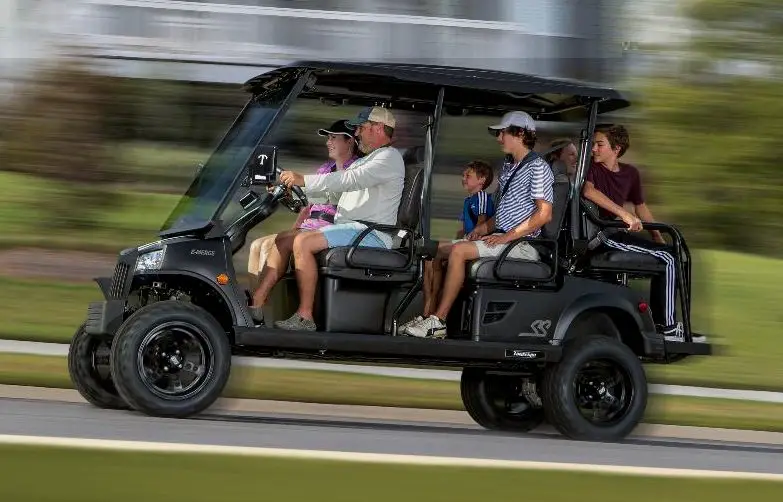How Many Golf Carts Are There In The World

Golf carts, those compact vehicles commonly seen zipping around golf courses, have steadily emerged as a ubiquitous presence in our modern world. But just how many golf carts are there in existence? It’s a question that piques curiosity and sparks intrigue. To embark on this quest for knowledge, we delve into the realm of golf carts, exploring their types, factors influencing their popularity, estimation methodologies, regional analysis, innovative applications, challenges, and future prospects.
Beyond their traditional role in golfing, golf carts have found their way into retirement communities, resorts, campuses, and even urban environments. They offer convenient and eco-friendly mobility, making them an attractive choice for short-distance transportation needs. As the usage of golf carts continues to expand, the global count of these vehicles becomes a subject of fascination, prompting us to uncover the factors that contribute to their prevalence and estimate their numbers worldwide.
Join us on this journey as we navigate through the intricacies of golf cart culture, examining their types, analyzing regional trends, considering their impact on sustainability, exploring innovative applications, and peering into the future of these fascinating vehicles. Together, we will unravel the enigma and shed light on the ever-growing world of golf carts.

Understanding Golf Carts
Golf carts are small motorized vehicles designed for short-distance travel, primarily on golf courses. They are typically used to transport golfers and their equipment between holes, enhancing the overall golfing experience. However, their utility extends beyond the fairways. Let’s take a closer look at the different types of golf carts and their functionality.
Types of Golf Carts
Golf carts come in various configurations to suit different needs and preferences. Here are three commonly encountered types:
- Electric Golf Carts: These carts are powered by rechargeable batteries, making them environmentally friendly and cost-effective. Electric golf carts are known for their quiet operation, low maintenance requirements, and emission-free transportation.
- Gas-Powered Golf Carts: Gasoline-powered golf carts utilize internal combustion engines, similar to those found in automobiles. These carts offer higher speeds and longer ranges compared to their electric counterparts. However, they require regular refueling and emit exhaust gases.
- Solar-Powered Golf Carts: Solar-powered golf carts harness the energy of the sun through solar panels installed on the cart’s roof. These panels convert sunlight into electricity, reducing reliance on external charging. While still relatively uncommon, solar-powered golf carts are gaining attention for their sustainability.
Role of Golf Carts in Golf Courses and Beyond
Beyond their primary function of transporting golfers during a game, golf carts play a significant role in golf course management and maintenance. These vehicles assist in maintaining the course’s condition by enabling groundskeepers to easily access various areas with tools and supplies. Moreover, golf carts have become a symbol of convenience and leisure in retirement communities, resorts, and other recreational settings.
Factors Influencing Golf Cart Popularity
Several factors contribute to the growing popularity of golf carts worldwide. Understanding these influences helps shed light on why these vehicles have gained widespread usage beyond golf courses. Let’s explore some of the key factors.
Golf Course Density and Expansion
The number and size of golf courses in a given region directly impact the demand for golf carts. Areas with a high concentration of golf courses, such as golfing hubs or tourist destinations, often see a greater presence of golf carts. Additionally, as new courses are developed and existing ones expand, the demand for golf carts increases correspondingly.
Retirement Communities and Resorts
Retirement communities and resorts have emerged as major consumers of golf carts. These settings provide an ideal environment for the use of golf carts, offering convenience, mobility, and accessibility for residents and guests. The retiree population’s preference for golf as a recreational activity further fuels the demand for golf carts in these communities.
Environmental Benefits of Electric Golf Carts
With the growing emphasis on sustainability and eco-friendly practices, electric golf carts have gained traction due to their environmental benefits. Compared to gas-powered counterparts, electric golf carts produce zero tailpipe emissions and significantly reduce noise pollution. These factors make electric golf carts an attractive choice for environmentally conscious individuals and organizations.
Estimating the Global Count of Golf Carts
Determining the exact number of golf carts worldwide is no easy

Continue writing pleaseChatGPT
task due to various factors like diverse ownership, regional differences, and the presence of secondary markets. However, by employing specific methodologies and considering relevant data sources, estimates can be made to provide a general understanding of the global count of golf carts.
Methodology and Data Sources
Estimating the global count of golf carts requires a combination of primary and secondary data sources. Here are some common methodologies and data sources used in this process:
- Golf Cart Sales Statistics: Tracking the sales figures of golf cart manufacturers provides valuable insights into the number of new carts entering the market. Manufacturers often release annual sales reports, which can be analyzed to estimate the global count.
- Regional and Country-Specific Factors: Different regions and countries exhibit varying levels of golf cart adoption. Factors such as golfing culture, infrastructure, and economic conditions influence the prevalence of golf carts. Analyzing regional and country-specific data helps refine the estimation process.
- Secondary Markets and Private Ownership: Apart from new sales, golf carts also change hands in secondary markets, including auctions, private sales, and lease returns. Accounting for these transactions adds depth to the estimation process, considering the circulation of pre-owned carts.
Key Considerations for Estimation
Estimating the global count of golf carts necessitates careful consideration of various factors. Let’s delve into some key considerations that contribute to a more accurate estimation:
- Golf Cart Sales Statistics: As mentioned earlier, analyzing sales data from golf cart manufacturers is an essential starting point. This data provides an overview of new carts entering the market, giving us a baseline for estimation.
- Regional and Country-Specific Factors: Different regions and countries have unique golfing landscapes, infrastructure, and cultural preferences. By considering these factors, we can adjust our estimates to reflect the varying popularity of golf carts in different parts of the world.
- Secondary Markets and Private Ownership: Secondary markets play a significant role in the golf cart ecosystem. Many carts change hands through private sales, auctions, or lease returns. Incorporating the data from these secondary markets provides a more comprehensive view of the total number of golf carts in circulation.
Analyzing Golf Cart Usage by Region
To gain a deeper understanding of the global count of golf carts, it is essential to analyze the usage patterns and prevalence in different regions. Let’s explore the usage trends in some key regions around the world:
North America
North America has a long-standing golfing tradition, making it a significant market for golf carts. The United States alone boasts thousands of golf courses, many of which heavily rely on golf carts for transportation. Additionally, retirement communities and golf resorts contribute to the substantial presence of golf carts in this region.
Europe
In Europe, golfing trends and accessibility vary across different countries. Golf carts are prevalent in countries like the United Kingdom, Spain, and Portugal, which attract golf enthusiasts and offer a wide range of courses. Popular tourist destinations in Europe often feature golf resorts, further boosting the demand for golf carts.
Asia-Pacific
The Asia-Pacific region has witnessed a surge in golfing popularity in recent years. Countries like South Korea, Japan, and China have seen significant growth in golf course development and participation. As a result, the demand for golf carts in this region is on the rise. Moreover, environmental initiatives and the promotion of electric vehicles contribute to the adoption of electric golf carts in some countries.
Rest of the World
In Latin America, countries like Mexico, Brazil, and Argentina exhibit a growing interest in golf, with the presence of golf resorts and courses. Similarly, the Middle East, particularly the United Arab Emirates, boasts world-class golf facilities and resorts that utilize golf carts to enhance the golfing experience in the region.
Understanding the usage patterns and prevalence of golf carts in different regions helps us gauge their global count more accurately.

Continue writing pleaseChatGPT
Innovative Applications of Golf Carts
While golf carts are primarily associated with golf courses, their versatility extends beyond the fairways. Let’s explore some innovative applications of golf carts in various settings:
Non-Golf Uses of Golf Carts
Golf carts have found utility beyond the golfing realm. They are increasingly used as a convenient mode of personal transportation in various contexts. Here are a few examples:
- Personal Transportation: Golf carts are popular for navigating large properties such as residential communities, campuses, and industrial complexes. They provide a convenient and efficient means of getting around, particularly for short distances.
- Campus and Industrial Transportation: Educational institutions and industrial facilities often employ golf carts for efficient transportation within their premises. These vehicles are used by staff, students, and workers to move between buildings, saving time and reducing the reliance on larger vehicles.
Electric Golf Carts in Urban Mobility
With the global shift towards sustainable transportation, electric golf carts are being explored as a viable solution for urban mobility. Here’s a closer look at the benefits and initiatives related to electric golf carts:
- Benefits for Short-Distance Travel: Electric golf carts offer an eco-friendly alternative for short-distance travel in urban areas. They produce zero emissions, reduce traffic congestion, and have a smaller footprint compared to traditional automobiles. Electric golf carts can be particularly useful for commuting within neighborhoods, city centers, and designated car-free zones.
- Initiatives and Pilot Programs: Several cities around the world are implementing initiatives to integrate electric golf carts into their urban mobility plans. Pilot programs are being conducted to test the feasibility and benefits of using golf carts as a sustainable mode of transportation. These initiatives aim to reduce pollution, improve accessibility, and enhance the overall urban transportation experience.
Challenges and Future Prospects
While golf carts offer numerous benefits, their widespread adoption and integration into various contexts come with challenges. Let’s explore some of the challenges and future prospects associated with golf carts:
Environmental Impact and Sustainability
The environmental impact of golf carts, particularly gas-powered models, remains a concern. Emissions from gas-powered carts contribute to air pollution and carbon emissions. However, the growing popularity of electric golf carts is gradually mitigating these concerns. Transitioning to electric-powered models reduces the environmental footprint of golf carts, contributing to a more sustainable transportation solution.
Advancements in battery technology and the development of efficient charging infrastructure are crucial for the future sustainability of golf carts. By improving battery range, charging times, and overall performance, electric golf carts can become an even more attractive alternative to their gas-powered counterparts.
Regulations and Safety Measures
As the usage of golf carts expands beyond golf courses, regulations and safety measures become important considerations. Governments and local authorities are implementing regulations to ensure the safe operation of golf carts on public roads and within communities. These regulations may include licensing requirements, age restrictions, and speed limits.
Additionally, manufacturers are incorporating safety features in golf carts to enhance user safety. These features may include seat belts, headlights, turn signals, and rearview mirrors. Promoting awareness about safe driving practices and providing proper training for golf cart users also play a crucial role in ensuring their safe operation.
Technological Advancements and Autonomous Golf Carts
Technological advancements have the potential to shape the future of golf carts. The development of autonomous or self-driving golf carts is an exciting prospect. Autonomous technology could enable golf carts to navigate predetermined routes, further enhancing their convenience and usability in various settings. However, the deployment of autonomous golf carts comes with its own set of challenges, such as ensuring safety, regulatory compliance, and user acceptance.
Conclusion
In our pursuit of understanding the global count of golf carts, we have uncovered a rich tapestry of information that showcases the widespread popularity and versatility of these compact vehicles. While determining the exact number of golf carts in the world remains a challenging task due to diverse ownership, regional differences, and the presence of secondary markets, we have explored methodologies and factors that contribute to estimation.
From electric and gas-powered carts to solar-powered innovations, golf carts have transcended their origins on the golf course, finding applications in retirement communities, resorts, campuses, and even urban mobility initiatives. They offer convenient, eco-friendly, and efficient transportation for short distances, enhancing mobility while reducing environmental impact.
Regional analysis has revealed the prominence of golf carts in North America, Europe, Asia-Pacific, and other parts of the world, reflecting diverse golfing cultures and market dynamics. Additionally, we have witnessed the potential of golf carts in non-golf contexts, serving as personal transportation options and playing a role in urban mobility initiatives.
However, as golf carts continue to evolve and expand their presence, challenges lie ahead. Environmental impact, regulations, and safety measures necessitate careful consideration to ensure sustainable and safe usage. Technological advancements, including autonomous capabilities, offer glimpses of an exciting future for golf carts.
In conclusion, while we may not have an exact count of how many golf carts exist globally, our exploration has provided valuable insights into their widespread usage, applications, and the factors influencing their popularity. The world of golf carts is a dynamic one, continually evolving and shaping the way we move and explore our surroundings.





